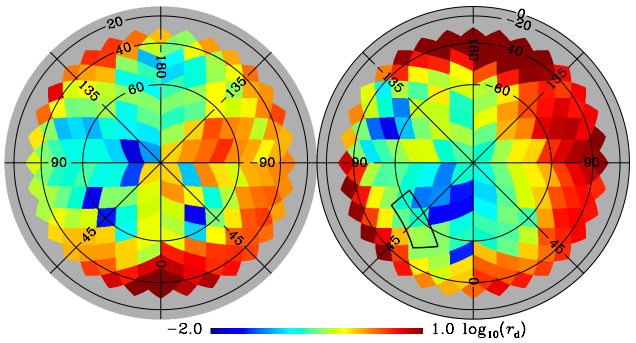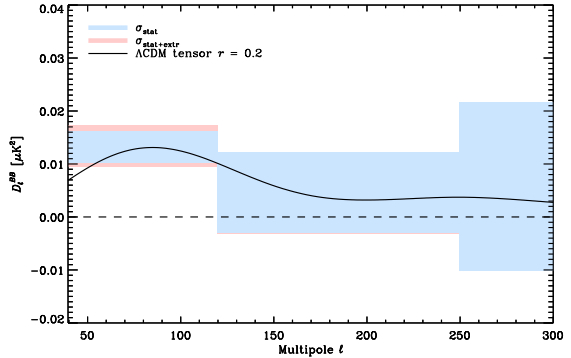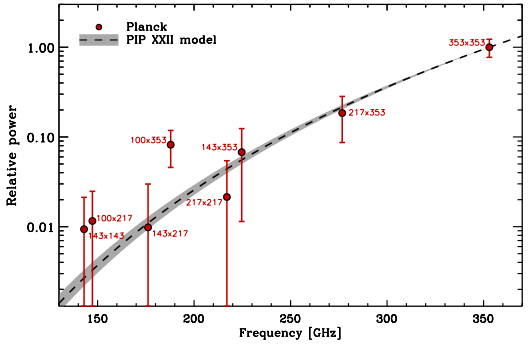Ever since we all heard the exciting news that the BICEP2 experiment had detected “B-mode” polarization in the cosmic microwave background — just the kind we would expect to be produced by cosmic inflation at a high energy scale — the scientific community has been waiting on pins and needles for some kind of independent confirmation, so that we could stop adding “if it holds up” every time we waxed enthusiastic about the result. And we all knew that there was just such an independent check looming, from the Planck satellite. The need for some kind of check became especially pressing when some cosmologists made a good case that the BICEP2 signal may very well have been dust in our galaxy, rather than gravitational waves from inflation (Mortonson and Seljak; Flauger, Hill, and Spergel).
Now some initial results from Planck are in … and it doesn’t look good for gravitational waves. (Warning: I am not a CMB experimentalist or data analyst, so take the below with a grain of salt, though I tried to stick close to the paper itself.)
Planck intermediate results. XXX. The angular power spectrum of polarized dust emission at intermediate and high Galactic latitudes
Planck Collaboration: R. Adam, et al.The polarized thermal emission from Galactic dust is the main foreground present in measurements of the polarization of the cosmic microwave background (CMB) at frequencies above 100GHz. We exploit the Planck HFI polarization data from 100 to 353GHz to measure the dust angular power spectra CEE,BBℓ over the range 40<ℓ<600. These will bring new insights into interstellar dust physics and a precise determination of the level of contamination for CMB polarization experiments. We show that statistical properties of the emission can be characterized over large fractions of the sky using Cℓ. For the dust, they are well described by power laws in ℓ with exponents αEE,BB=−2.42±0.02. The amplitudes of the polarization Cℓ vary with the average brightness in a way similar to the intensity ones. The dust polarization frequency dependence is consistent with modified blackbody emission with βd=1.59 and Td=19.6K. We find a systematic ratio between the amplitudes of the Galactic B- and E-modes of 0.5. We show that even in the faintest dust-emitting regions there are no "clean" windows where primordial CMB B-mode polarization could be measured without subtraction of dust emission. Finally, we investigate the level of dust polarization in the BICEP2 experiment field. Extrapolation of the Planck 353GHz data to 150GHz gives a dust power ℓ(ℓ+1)CBBℓ/(2π) of 1.32×10−2μK2CMB over the 40<ℓ<120 range; the statistical uncertainty is ±0.29 and there is an additional uncertainty (+0.28,-0.24) from the extrapolation, both in the same units. This is the same magnitude as reported by BICEP2 over this ℓ range, which highlights the need for assessment of the polarized dust signal. The present uncertainties will be reduced through an ongoing, joint analysis of the Planck and BICEP2 data sets.
We can unpack that a bit, but the upshot is pretty simple: Planck has observed the whole sky, including the BICEP2 region, although not in precisely the same wavelengths. With a bit of extrapolation, however, they can use their data to estimate how big a signal should be generated by dust in our galaxy. The result fits very well with what BICEP2 actually measured. It’s not completely definitive — the Planck paper stresses over and over the need to do more analysis, especially in collaboration with the BICEP2 team — but the simplest interpretation is that BICEP2’s B-modes were caused by local contamination, not by early-universe inflation.
Here’s the Planck sky, color-coded by amount of B-mode polarization generated by dust, with the BICEP2 field indicated at bottom left of the right-hand circle:
Every experiment is different, so the Planck team had to do some work to take their measurements and turn them into a prediction for what BICEP2 should have seen. Here is the sobering result, expressed (roughtly) as the expected amount of B-mode polarization as a function of angular size, with large angles on the left. (Really, the BB correlation function as a function of multipole moment.)
The light-blue rectangles are what Planck actually sees and attributes to dust. The black line is the theoretical prediction for what you would see from gravitational waves with the amplitude claimed by BICEP2. As you see, they match very well. That is: the BICEP2 signal is apparently well-explained by dust.
Of course, just because it could be dust doesn’t mean that it is. As one last check, the Planck team looked at how the amount of signal they saw varied as a function of the frequency of the microwaves they were observing. (BICEP2 was only able to observe at one frequency, 150 GHz.) Here’s the result, compared to a theoretical prediction for what dust should look like:
Again, the data seem to be lining right up with what you would expect from dust.
It’s not completely definitive — but it’s pretty powerful. BICEP2 did indeed observe the signal that they said they observed; but the smart money right now is betting that the signal didn’t come from the early universe. There’s still work to be done, and the universe has plenty of capacity for surprising us, but for the moment we can’t claim to have gathered information from quite as early in the history of the universe as we had hoped.



Heartbreaking.
Will the BICEP2 people be sending a camera team around to Linde’s house to see his reaction to this?
Thank you Dr. Carroll for the concise summary. I understand this is not strictly your field, but perhaps someone else might be able to answer my question as well.
Can the Planck data, in combination with the BICEP2 results now place an upper-limit on the B-mode polarization left over from the big bang?
Since we have the BICEP2 measurement, and the Planck estimate of the contribution due to dust (and the two are in close agreement), does this mean that there is little to no polarization due to the big bang visible in the BICEP2 data?
Seriously though: the BICEP people have lost all credibility with me. YMMV, but it’s clear that the whole thing was a huge gamble on their part. The thing is, though, that when you gamble and lose, you should expect to pay up…..
As a member of the Planck Science Team, I would urge caution concerning the interpretation. What we are saying is that polarised dust emission in the BICEP2
field is high. But it may be that there is something left in the BICEP2 signal that
can be attributed to gravitational waves. We need to cross-correlated the Planck
maps with the BICEP2 maps. This analysis is underway.
Claiming the team has lost credibility is ridiculous. This is what science is all about – a messy process of finding what’s really out there. Mistakes happen all the time and science has given us tools to detect these mistakes and to learn from them. What happens next will be very interesting.
Pingback: Los resultados de BICEP2 casi desmentidos por los datos de Planck | Ciencia DiY
What still makes me unhappy is that Bicep hyped to the press before a single referee report was received. That cannot be called science. When Podolsky stepped to the press about the Einstein-Podolsky-Rosen paper, Einstein got furious.
Prof Carroll: The paper has 229 co-authors, and the c.v.s of the leaders are, um, impressive. Just Google the name of the reader Efstathiou: it makes a compelling case that he knows his way around a telescope and a thing or two about space dust.
Ivo: This is surely going to leave some sort of a mark, even if it turns out BICEP2’s data is at least promising on gravitational waves. There’s a list of multiple basic things the members of the BICEP2 team did wrong.
Good stuff Sean. When all this brewed up along with that camera team sent round to Linde’s house, I was suspicious. I smelled hype. It got me thinking about inflation, and the motivation for it. And when I looked at it afresh, I couldn’t find any. The universe is “flat”, it was flat a billion years ago, and a billion years before that. It’s always been flat. Yes the early expansion would have been rapid, and yes something akin to gravitational time dilation would have made it look even more rapid. But inflation just slips between my fingers, and I’m left saying “Who ordered that?”
Ah well there goes another Physics video! http://m.youtube.com/watch?list=PLe8xQ_k69s17SX-GD_GbrM6xLAgdQdXdM&v=TPLefjvqHuw
Just a thought. Perhaps the dust particles are behaving as they do because of the presence of gravitational waves?
I was amazed at the time when they held a press conference and then filmed the visit to Linde’s house! Didn’t they appreciate that extraordinary claims require extraordinary proof. This is not how science should be done, the BICEP people have really trashed their reputations
Well, that is disappointing! Certainly data is more convincing than the expert analysis of Flauger et al.
And kudos to Efstathiou to pitch in!
Of course, there are problems (for this naive layman).
– Dust estimates have been much lower, see the BICEP2 main paper. (But estimates of course.)
– BICEP2 is measuring at the frequency. Planck is extrapolating.
– Planck is not entirely compatible with all the data. And there has been papers that seem to remove many of these by different data handling. (Not using masks, say.)
In sum, I’m not convinced that Planck’s dust models are any safer than BICEP2’s B-mode models. But it would have been nice to have a conclusive result (i.e. Planck agreeing with BICEP2) already.
@David McKormick: You don’t respond to ivo’s previosu claim that it is ridiculous to claim that the BICEP2 team has lost credibility (or worse, trashed their reputations).
And if you had read their presentations, you would know that they appreciated that “extraordinary claims require extraordinary proof.” That is why they used 1 whole year to try to tear their own data and models down, without success, before publishing.
What is new here is Planck’s dust analysis, previously unavailable.
Big error bars. That’s not a great fit to the data points, without those error bars. Both teams have a point of view that colors their analysis. It does appear. Reaction here also reveals biases through quick judgments. Analysis is in progress. We’ll have more data soon enough. Better data, not this finger pointing, will tighten up those nasty error bars. (Nasty, or convenient, depending on your stance.) Then, we’ll know. No purpose is served by picking sides. My own opinion is unmoved: the Planck team’s existing data was always going to be inconclusive. The BICEP2 team’s result was a best-faith estimate. So, we keep digging. We’ll get our answer.
Dr Chris Dawe says: “Ah well there goes another Physics video!”
If you do a replacement, please note that we don’t actually know that the universe started out as a point-singularity. Read Kevin Brown’s formation and growth of black holes, and you can see mention of Oppenheimer’s original “frozen star” interpretation. He doesn’t favour it, but it’s legit. And for all we know, the early universe was like one big cold frozen-star black hole thing where everything was the same and nothing ever happened. Until pop, something did.
The fact that some sort of self-correction can take place gives reassurance to lay persons like me.
But the silver edge still gives an impression of a background dark cloud. That being an impression of a dogma that must be satisfied. (The reaction of Alan Guth taken into account.).
As Sean has said: Be especialy careful if you would like things to be according to your belief of what reality should be.
Pingback: BICEP2 y los nuevos resultados sobre el polvo galáctico del telescopio Planck | Ciencia | La Ciencia de la Mula Francis
Pingback: Planck ‘dice’ che il segnale di BICEP2 sarebbe un artefatto sperimentale | AstronomicaMens
The problem is that people don’t understand galaxies.
Sean, you cannot possibly have polarization of electromagnetic waves without the existence of baryonic material. Everybody know that.
What interests me is what this will ultimately mean for the status of Inflationary Theory as contemporary cosmologies favorite explanation our universe’s earliest history. This signal as widely touted as extremely good for Inflationary Theory and even a prediction of said theory.
If this signal turns out to be dust, then what of this Inflation’s prediction? Can the theory survive? If so, how? From what I can gather as a layman a null signal would mean only lower energy inflationary theories could survive and I think Professor Carroll has said in previous papers that this puts limits on the explanatory power of inflation.
Please, more on what a null signal of b-mode polarization would ultimately mean for the latest cosmological theories!
Correct me, please, it’s likely that I am wrong. Having said that, it doesn’t look like nothing was ruled out, only that the result was really inconclusive. They got the dust signal for 353GHz and saw that the patch had too much dust. Then they estimated back to 150GHz and still saw the dust, but with a very large uncertainty, which could be either compatible with r=0, but also compatible with higher values.
So, what the Planck team will do now is to try to analyze a region with very little dust, it’s very close to the patch analyzed by BICEP2, and is labeled by a blue color, for low dust noise. So, Plank will look for gravitational waves there. I am not sure, but BICEP2 will either interpolate their estimates of signal vs. noise with Plank’s in that region and match with compare with the latter. So, we will have 2 regions analyzed 150GHz and 353GHz. The error might might or not still be big.
Indeed, nothing was ruled out. And as George Efstathiou says above, we’ll have to wait for a joint analysis before drawing any really definitive conclusions. But the new result seems to make it clear that there is no problem explaining the BICEP2 observations with dust alone. Therefore, we can’t really say there is any good evidence for gravitational waves (although they may, of course, be there).